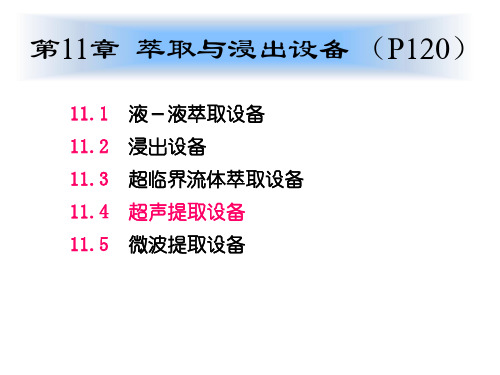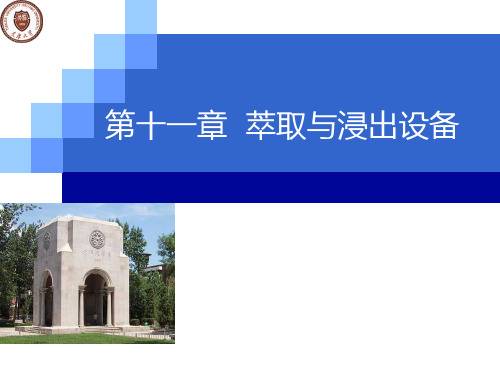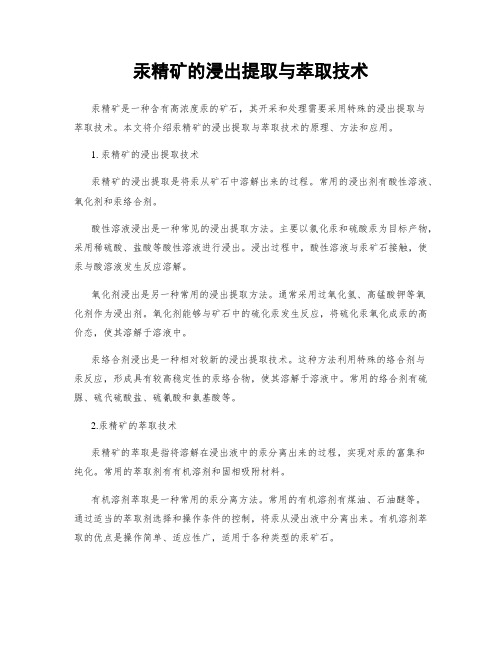第十一章 浸出与萃取
萃取与浸提

到纯化或浓缩的单元操作叫做萃取
属于两相之间的传质过程
初步分离纯化技术
应用:
石油化工、湿法冶金、医药、食品、环境
固液萃取(浸取) 物理状态 液液萃取
有机溶液萃取
双水相萃取
液膜萃取 反胶束萃取
超临界萃取
分 物理萃取 萃取原理 化学萃取 分批萃取 操作方式 连续萃取 单级萃取 操作方式 多级萃取
第二种情况较常见,第三种情况应
避免,第一种情况较少
2.2.1 溶解度曲线与连接线
右图,为典型的平衡相图,表示 在一定温度和压力下,A、B、和
S三组分混合达平衡的相图,其
中B、S是部分互溶
图中,
溶解度曲线
共轭线与连接线 混溶点与两个相区
连接线倾斜,方向一致,但不平行
2.3 杠杆规则
如图所示,设点M为三组分混合物的总组成点,M 与料液F和萃取剂S之间,M与萃取相E和萃余相R 之间符合杠杆规则。即符合以下比例关系
采用以下模型:
假定在不溶性的多孔惰性固体 (A量)内部含有不被固体所吸附的溶质B。
溶质量B对所加溶剂量S而言,假定是在饱和溶解度以下。如果固体与
溶剂经过长时间的充分接触,则溶质完全溶解,并且固体空隙中的液体 浓度等于周围液体的浓度,这时液体的组成不随更长的接触时间而改变。 这种级接触则称为理论级。或称理论效。
湿法冶炼中的浸出与萃取

搅拌强度对混合效率和传质速率有重 要影响,搅拌强度不足会影响传质效 果,导致分离效率降低。
料液的浓度
料液中目标物质的浓度直接影响萃取 效果,浓度过高或过低都会影响分离 效果。
搅拌强度
温度和压力的变化会影响萃取剂的溶 解度和目标物质的挥发性,进而影响 萃取效果。
04
浸出与萃取的比较与选择
浸出与萃取的优缺点比较 浸 01
原料性质
对于某些特定原料,如 高品位矿石或易浸出的 矿物,浸出可能更合适
。
产品要求
如果需要高纯度产品, 萃取可能更合适。
生产规模
大规模生产时,浸出可 能更具优势。
浸出与萃取的联合流程
1 2
3
先浸出后萃取
原料经过浸出处理后,浸出液中的目标组分再进行萃取分离 。
先萃取后浸出
原料经过萃取处理后,萃取液中的目标组分再进行浸出处理 。
锌的浸出与萃取
锌的浸出
在锌的湿法冶炼过程中,通常采用硫酸作为浸出剂,将锌矿石中的锌离子浸出到溶液中。硫酸与矿石 中的锌反应生成硫酸锌,同时伴有其他金属离子的浸出。
锌的萃取
浸出液中的锌离子通过萃取剂(如环己酮)的选择性吸附作用,从浸出液中被提取出来。萃取剂将锌 离子从浸出液转移到有机相中,实现锌与其他金属离子的分离。
根据萃取剂的种类,萃取过程可分为 有机溶剂萃取、离子交换萃取和协同 萃取。
VS
有机溶剂萃取是利用有机溶剂对目标 物质的溶解度进行萃取分离;离子交 换萃取是利用离子交换剂对溶液中的 离子进行交换分离;协同萃取是利用 两种或多种萃取剂的协同作用进行萃 取分离。
萃取过程的设备
萃取设备主要包括混合器、分离器和 洗涤器。
同时浸出与萃取
第11章_萃取和浸出设备-PPT精选文档

2、喷射式混合器
(1)类型及作用
弯头交错喷嘴混合器、同向射流混合器、 孔板射流混合器
弯头交错喷嘴混合器
两液相已在器外汇合, 然后进入器内经喷嘴或 孔板后,加强了湍流程 度,从而提高了萃取效 率。
同向射流混合器
孔板射流混合器
(2)特点
喷射式混合器是一种体积小效率高的 混合装置,特别适用于低黏度、易分 散的料液。这种设备投资小,但需要 料液在较高的压力下进入混合器。
2、分类
(二)混合设备
1、混合管
(1)工作原理
萃取剂及料液在一定流速下进入管道一端,混合后从 另一端导出,依靠管内特殊设计的内部单元和流体流 动实现液体混合。 强迫湍流状态;料液在管内平均停留时间10~20s。
(2)特点
混合管的萃取效果高于混合罐,且为连续操作。流程 简单、结构紧凑、能耗小、萃取效率高。适于各种黏 度的流体。
(2)操作过程
取药材 → 粉碎 → 装入萃取器 → 通CO2排 空气 → 开进气阀(12)及气瓶阀门 → 启 动高压泵 → 当压力升到预定压力时再调节 减压阀(9)→ 打开放空阀(10)→ 调节 流量稳定 → 半闭阀门(10),打开阀门 (11)→ 开放油阀(8)放出萃取液
第3节 浸出设备
3、超临界流体萃取的技术原理
在超临界状态下,将超临界流体与 待分离的物质接触,使其有选择性地把 极性大小、沸点高低和分子量大小的成 分依次萃取出来,然后借助减压、升温 的方法使超临界流体变成普通气体,被 萃取物质则完全或基本析出,从而达到 分离提纯的目的。
4、超临界CO2流体萃取装置及 工艺流程
一、基本原理
1、超临界流体的概念
温度和压力高于临界温度和临界压力的流体 称为超临界流体(Supercritical Fluid)。 三相呈平衡态共存的点叫三相点。液、气两 相呈平衡状态的点叫临界点。 高于临界温度和临界压力而接近临
《浸出和萃取》课件

在制药工业中的应用
提取药物有效成分: 通过浸出和萃取技术, 从植物、动物、微生 物等天然资源中提取 药物有效成分
提高药物纯度:通过 浸出和萃取技术,提 高药物纯度,降低杂 质含量,提高药物安 全性和有效性
药物合成:通过浸出 和萃取技术,合成药 物中间体和原料药, 提高药物生产效率和 质量
药物分离:通过浸出 和萃取技术,分离药 物中的有效成分和杂 质,提高药物纯度和 安全性
浸出和萃取的经济性比较
浸出:设备投资大,运行成本低,适合大规模生产 萃取:设备投资小,运行成本高,适合小规模生产 浸出:能耗高,环境污染大,需要处理废液 萃取:能耗低,环境污染小,无需处理废液
浸出和萃取的适用范围比较
浸出:适用于处理低浓度、难溶性物质,如矿石、煤等 萃取:适用于处理高浓度、易溶性物质,如金属离子、有机物等 浸出:适用于大规模生产,如工业废水处理、矿山开采等 萃取:适用于实验室研究,如化学分析、药物合成等
步骤
浸出效果:取 决于浸出剂的 选择、浸出温 度、时间等因
素
浸出过程
浸出剂的选择:根据待浸出物质 的性质选择合适的浸出剂
搅拌和混合:通过搅拌和混合, 使浸出剂与待浸出物质充分接触题
添加标题
浸出温度和时间:控制浸出温度 和时间,以获得最佳浸出效果
过滤和分离:将浸出液与待浸出 物质分离,得到浸出液和待浸出 物质
感谢观看
汇报人:
浸出影响因素
浸出剂的性质:如酸碱性、浓度、温度等
固体物料的粒度大小
浸出时间的长短
浸出剂与固体物料的接触面积
浸出温度的高低
浸出剂的流速和搅拌速度
浸出设备
浸出罐:用于盛放浸出液和固体物料
冷却器:降低浸出液的温度,便于后 续处理
萃取和浸取

废液
混合分离器1
混合分离器2
混合分离器n
产物+溶剂
溶剂
多级逆流萃取流程的特点:料液走向和萃取剂走向相反,只 在最后一级中加入萃取剂,萃取剂消耗少,萃取液产物平均 浓度高,产物收率较高。 工业上多采用多级逆流萃取流程。
多级逆流液液流程示意图
溶剂萃取
萃取分率
1
n
n1 n1
04常见浸取物精品资料产物固体溶质溶剂咖啡粗烤咖啡咖啡溶质水豆油大豆豆油己烷大豆蛋白豆粉蛋白质naoh溶液ph9挥发油植物萜类芳香族化合物水香料丁香胡椒麝香草香料成分80乙醇蔗糖甘蔗甜菜蔗糖水维生素b碎米维生素b乙醇水玉米蛋白质玉米玉米蛋白质90乙醇果汁水果块果汁水鱼油碎鱼块鱼油己烷丁醇ch2cl2鸦片提取物罂粟鸦片提取物ch2cl2或超临界co2胰岛素牛猪胰腺胰岛素酸性醇肝提取物哺乳动物的肝肽缩氨酸水低水分水果高水分水果水50的糖液脱盐海藻海藻海盐稀盐酸去咖啡因的咖啡绿咖啡豆咖啡因氯代甲烷超临界co2中草药汁中草药材药用成分水药酒中草药材药用成分酒精品资料?挥发油
碟片上开有小孔, 乳浊液通过小孔流 到碟片间隙。在离 心力作用下,重液 倾斜沉向于转鼓的 器壁,由重液排出 口流出。轻液则沿 斜面向上移动,汇 集后由轻液排出口 流出。
(4)离心萃取机
①ABE-216离心萃取机
ABE-216型离心萃取机结构图
ABE-216型离心萃取机液体流向示意图
②Podbielniak离心萃取机(简称POD机)
萜类、芳香族化合物、小分子脂肪等 具有驱风和局部刺激作用,用于止咳、平喘、祛痰、
x ——平衡时溶质在固相中的浓度。 y和x用体积浓度(kg/m3)表示,KD值一般为常数。
湿法冶炼中的浸出与萃取

利用化学或生物方法将污染物从固相中转移到液相中,实现污染物的初步分离。
浸出
将污染物从液相中提取出来,进行富集和浓缩,便于后续处理。
萃取
土壤和地下水的修复过程中,通过浸出和萃取技术,有效去除重金属和有机污染物。
实例
在太阳能电池制造过程中,通过化学浸出技术制备薄膜材料。
浸出
萃取
实例
在燃料电池中,利用萃取剂将氢气和氧气分别提取出来,为燃料电池提供反应物质。
萃取剂的选择
选择合适的萃取剂是实现有效萃取的关键。萃取剂应具备对目标金属离子高选择性、良好的萃取性能和分离效果、低能耗和环境污染小的特点。同时,萃取剂还应具备稳定性好、不易分解和易于再生等优点,以保障萃取过程的长期稳定运行。
萃取过程
利用溶质在两种不互溶的溶剂中溶解度的差异,实现溶质从一种溶剂转移到另一种溶剂中的分离过程。
相关案例研究
总结词:详细描述了某矿物冶炼厂如何通过浸出与萃取工艺流程提取有价值的金属,包括浸出和萃取的原理、工艺流程、设备选择以及操作要点等。详细描述:某矿物冶炼厂采用湿法冶炼技术,首先通过浸出工艺将矿石中的有价金属以离子形式溶解在溶液中,然后通过萃取工艺将有价金属离子从浸出液中提取出来,最终得到高纯度的金属。在浸出过程中,矿石经过破碎、磨细后与酸或碱等浸出剂进行反应,使金属离子进入溶液中。在萃取过程中,使用有机溶剂将金属离子从浸出液中提取出来,再通过反萃取和置换等操作,最终得到纯度较高的金属。该工艺流程具有较高的提取率和较低的环境污染,是当前矿物冶炼领域中较为先进的工艺技术之一。
相似相溶原理
萃取过程中,溶质在两相之间的分配达到动态平衡状态,遵循质量作用定律和分配定律。
平衡理论
萃取过程涉及相际传质,即溶质在两相界面处进行传递,实现分离。
9-萃取与浸出

1999年引进德国伍德公司的6×1500L的设备
2000年引进德国伍德公司的3×3500L的设备
美国 Supercritical Processing Inc
1花椒有效成分的CO_2超临界萃取工艺 孙国峰 食品与生物技术学报 2011/06
2 成东药机超临界CO2萃取装置行业新标准获批 杨华登 机电信息 2011/26 3 超临界CO_2萃取麦冬中高异黄酮类物质的工艺研究 曾品涛 中国药业 2010/24 4 超临界CO_2萃取松花粉中的油脂及其GC分析 杨万政 承德医学院学报 2010/04 5 中药复方TF-103超临界CO_2萃取工艺研究 费陈忠 中兽医医药杂志 2009/03
超临界流体
tc,pc 200~300 (1~3)×10-5 7×10-8 tc,4pc
液 体
15~30º C
400~900 600~1600 (3~9)×10-5 (2~30)×10-5 2×10-8 (0.2~3)×10-9 (70~250)×1 (30~70)×10-3 0-3
流体名称
二氧化碳 水 氨 乙烷 氧化二氮
中药及中药提取物
调味品 香料、香精
萃取段
超临界二氧化碳萃取的工艺流程
解析段
常规萃取 萃取过程特殊性 夹带剂萃取 喷射萃取 等温法 解析方式不同分 等压 吸附法 多解析法
常规萃取
含夹带剂萃取
超临界二氧化碳萃取设备 组成:冷水系统、热水系统、萃取系统、分离系统、 夹带剂循环系统、二氧化碳循环系统和计算机控制系 统。
萃取釜
工业化超临界CO2萃 取设备
1.国产设备的生产情况
南通市华安超临界萃取有限公司
南通市华安超临界萃取有限公司
美晨集团股份 有限公司
钴的溶液浸出萃取电解法分离回收

钴的溶液浸出萃取电解法分离回收钴,作为重要的金属元素,被广泛运用于许多领域,包括电池制造、合金生产以及化工行业。
然而,钴的回收与再利用成为当今研究和关注的焦点之一。
在这个过程中,溶液浸出、萃取和电解等方法成为分离和回收钴的重要技术手段。
### 钴的溶液浸出钴通常存在于废弃电池、废旧设备或含钴矿石中。
钴的溶液浸出是指将这些含钴的物质置于溶剂中,通过化学反应将钴从固体基质中释放出来。
这个过程的效率和质量取决于溶剂的选择、温度和pH值等条件。
利用浸出技术,钴可从原始来源中被有效地提取出来。
### 萃取分离在溶液浸出的过程中,需要对混合液中的钴进行分离。
这时,萃取技术是一种关键的方法。
它通过在溶液中引入有选择性的提取剂来分离钴离子。
这些提取剂能与钴离子形成配合物,从而被分离出来。
选择合适的提取剂和调节萃取条件对于高效地分离钴至关重要。
### 电解回收萃取后得到的钴溶液需要经过电解过程来得到纯度更高的钴。
电解是将溶液置于电解槽中,施加电流使得钴离子在电极上析出,从而得到纯净的钴金属。
这个阶段的控制与操作对于生产高纯度的钴具有重要意义。
### 技术发展与前景随着科技的进步和环保意识的提高,钴的回收技术也在不断创新和改进。
有机溶剂萃取、膜分离等新技术的引入为提高钴回收率和降低生产成本提供了新思路。
此外,更加绿色和可持续的方法也在被研究,以减少对环境的影响。
### 结语钴的溶液浸出、萃取和电解法分离回收是一项复杂而关键的技术链条,对于促进资源再利用和环境保护具有重要意义。
随着科学技术的不断发展,我们可以预见这些技术会更加完善和成熟,为钴资源的高效回收和再利用提供更多可能。
通过钴的溶液浸出、萃取与电解法分离回收的过程,我们可以更好地了解这些技术在实现资源可持续利用方面的作用和重要性。
食品工程原理 第十一章浸出与萃取

选择溶剂的注意事项
适当的溶解选择性:所选用的溶剂应对所需浸提的成分有较高的溶解 度,而对其他的不需要浸提的成分有较小的溶解度 容易回收:溶剂的回收多采用蒸馏操作进行,因此溶剂应具有适当的 挥发性、低汽化热以及溶剂与溶质之间的相对挥发性较大 适当的密度:采用密度相近的溶剂进行浸提。 表面张力:故选择溶剂时,宜选用表面张力较小的溶剂,或添加适量 的表面活性剂 安全性及化学稳定性 :溶剂的挥发性不宜过高 ,本身应无毒性,且 不易分解变质,不与物料中的成分发生化学反应,以保证浸提成分的 安全性。
浸提过程
原料预处理(破碎或切片) 混合 分离
溶剂的选择
用溶剂法提取有效成分时,选择适当的溶剂是很重要的, 因为适宜的溶剂溶出的有效成分较多,无效的杂质较少。 根据相似相容原理(待提取成分于溶剂的分子极性越 相似,其溶解性就越大)在可采用单一有机溶剂进行 分步提取,也可采用混合溶剂进行提取。
分子中功能基的极性越大或极性功能基数量越多,整个分子 的极性就越大,亲水性就越强; 分子的非极性部分大或碳链越长,则极性越小,亲脂性强。
食品工业中主要有:
食用油的浸提 香料的浸提 咖啡豆可溶性成分的浸提 甜菜中糖分的浸提 天然色素的浸提
一、浸提的基本概念
浸提是将溶剂加入固相或另一液相混合物中,其 中所含的一种或几种组分溶出从而使混合物得到 完全或部分分离的过程。统称为溶剂萃取。 其中液体溶剂对固体混合物进行的溶质萃取过程 称为固-液萃取,也称为浸出、浸提或浸沥。
(一)、浸提平衡
浸提系统由3种组分,即溶剂、溶质 (目标浸提物)和惰性 固体构成。 浸提系统的平衡关系:极其复杂,其机理尚未完全搞清 楚。但较多采用以下模型:
假定在不溶性的多孔惰性固体 (A量)内部含有不被固体所吸附的 溶质B。 溶质量B对所加溶剂量S而言,假定是在饱和溶解度以下。如果固 体与溶剂经过长时间的充分接触,则溶质完全溶解,并且固体空 隙中的液体浓度等于周围液体的浓度,这时液体的组成不随更长 的接触时间而改变。这种级接触则称为理论级。或称理论效。
《浸出和萃取》课件

结果分析
根据实验结果,分析浸出和萃取的原 理、影响因素和应用前景。
图表制作
根据实验数据制作图表,直观展示实 验结果。
结论总结
总结实验的结论和收获,提出改进意 见和建议。
05
浸出和萃取的工业应用
在矿物加工中的应用
浸出
将矿石破碎、磨细后与浸出剂混合, 使有用组分溶解于浸出液中,再对浸 出液进行提取。这种方法广泛应用于 铜、铀等金属的提取。
优化浸出和萃取工艺,降低资源与能 源消耗,提高资源利用效率。
感谢您的观看
THANKS
原理
浸出过程基于化学反应,通过反应使目标物质从固体中溶解到液体中;萃取则 是利用溶质在两种不混溶的溶剂中的溶解度差异,实现组分的分离。
历史与发展
历史
浸出和萃取技术起源较早,随着 科技的发展和工业需求,不断得 到改进和完善。
发展
现代浸出和萃取技术正朝着高效 、环保、节能的方向发展,不断 有新的技术涌现,如超声波辅助 萃取、微波辅助萃取等。
萃取
在食品工业中,萃取技术常用于提取食品中的有效成分,如咖啡因、香精等。通 过选择合适的萃取剂,可以将所需成分从原料中提取出来,用于食品添加剂或调 味品生产。
在环境保护中的应用
浸出
在环境保护领域,浸出技术可用于处理土壤、污泥等固体废物。通过将溶剂浸入废物中 ,可以将有害物质溶解于溶剂中,再通过蒸发、分离等方法回收或处理有害物质,达到
净化废物的目的。
萃取
在环境保护领域,萃取技术可用于处理废水、废气等污染物。通过选择合适的萃取剂, 可以将废水、废气中的有害物质提取出来,进行分离、转化或回收利用,达到治理污染
的目的。
06
浸出和萃取的未来发展与 挑战
萃取与浸提

3.4 固体的浸提过程的步骤
1. 溶剂浸润进入固体内,溶质溶解 2. 溶解的溶质从固体内部流体中扩散达到固体表面 3. 溶质继续从固体表面通过液膜扩散到达外部溶剂的主体。
溶剂S 原料F0 溢流E1
底流W
3.5 萃取设备
单级浸取罐 级式固定床浸取装置 多级固定床浸取系统 设备 U型管式浸取器 连续移动床浸取装置 平转式浸取器
到纯化或浓缩的单元操作叫做萃取
属于两相之间的传质过程
初步分离纯化技术
应用:
石油化工、湿法冶金、医药、食品、环境
固液萃取(浸取) 物理状态 液液萃取
有机溶液萃取
双水相萃取
液膜萃取 反胶束萃取
超临界萃取
分 物理萃取 萃取原理 化学萃取 分批萃取 操作方式 连续萃取 单级萃取 操作方式 多级萃取
类
多级错流萃取 多级逆流萃取 微分萃取
2. 液液萃取
定义:
液-液萃取又称溶剂萃取,简称萃取,是两个完全或部分不互溶的
液相接触后,一个液相中的组分转移到另一液相,活在两液相中
重新分配的过程。 萃取剂(溶剂)S:所 用的溶剂;solvent 原料液F:所处理的 混合液;feed 溶质A:原料液中易 溶于溶剂的组分; 原溶剂(稀释剂) B:难溶或不溶组分。
浸取是固-液萃取,又称浸出、提取或浸提。由于食品加工 的原料大多为固体,要分离提取其中的成分,往往采取浸
取的方法,因此浸取在食品工业中得到广泛应用
应用
食用油的浸提
香料的浸提
咖啡豆可溶性成分的浸提 甜菜中糖分的浸提 天然色素的浸提
3.1 浸提的基本概念
浸提是将溶剂加入固相或另一液相混合物中,其中所
热浸
提取过 程
由于提高温度有利于有效成分的溶解 度故提取效果较冷浸好。该方法操作 时间长,浸出溶剂用量大往往浸出效 率差,不易完全浸出,不适合有效成 分含量低的原料
第11章 萃取与浸出设备ppt课件

➢ 多功能提取罐的工作过程:药材经加料口进入罐内,浸出 液从活底上的滤板过滤后排出。夹层可通入蒸气加热,或 通水冷却。排渣底盖,可用气动装置自动启闭。为了防止 药渣在提取罐内膨胀,因架桥难以排出,罐内装有料叉, 可借助于气动装置自动提升排渣。
➢ 2、多功能提取罐的种类 ➢ 如按设备外形分,有正锥形、斜锥形、直筒形三种形式; ➢ 按提取方法分,有动态提取和静态提取二种; ➢ 按中草药提取时罐内的承压情况大致可分为: ➢ ①真空提取:-0.1MPa≤罐内压力≤-0.02MPa
➢ 热回流循环提取浓缩机是一种新型动态提取浓缩机组,集 提取浓缩为一体,是一套全封闭连续循环动态提取装置。 该设备主要用于以水、乙醇及其他有机溶剂提取药材中的 有效成分、浸出液浓缩,以及有机溶剂的回收。
➢ 热回流循环提取浓缩机的基本结构如图11-12所示。
11.2.5 热回流循环提取浓缩机
图11-12 热回流循环提 取浓缩机示意图
➢ 2、平转式连续逆流提取器 ➢ 平转式连续逆流提取器结构为在旋转的圆环形容器内间
隔有12-18个料格,每个扇形格为带孔的活底,借活底下 的滚轮支承在轨道上,如图11-11(a)所示。
11.2.4 连续提取器
(a)结构图; (b)工作过程 图11-11 平转式连续逆流提取器示意图
11.2.5 热回流循环提取浓缩机
11.1.3 离心萃取机
➢ 1、多级离心萃取机
➢ 多级离心萃取机是在一台 设备中装有两级或三级混 合及分离装置的逆流萃取 设备。图11-3是Luwesta EK10007三级逆流离心萃 取机的示意图。
图11-3 Luwesta三级离心萃取 机结构
11.1.3 离心萃取机
➢ 3、倾析式离心机
浸出—萃取—电积法工艺实例

浸出—萃取—电积法工艺实例浸出—萃取—电积法工艺实例萃取法以主主要用于提取稀有金属。
由于萃取剂价格昂贵,故对铜的萃取工艺应用受到限制。
70年代以来,由于有机化学和石油化学工业的迅速发展,为制造和使用新型价廉、有效的萃取剂提供了条件,从而在铜的工业生产中采用萃取法成为可能。
溶剂萃取的显著特点是生产效率高、连续作业性强、适用于工业规模的生产、分离效果好、提取率高、操作简便、生产时“三废”少。
所以,近年来国外采取萃取法提铜的工业化生产逐年增加。
1968年美国亚利桑那州大牧场勘探和开发公司的兰乌矿,首先建成世界第一座铜的萃取—电积厂。
世界上铜的溶剂萃取—电积厂有十多座(表1),这些厂所采用的萃取剂几乎都是Lix-64N。
表1 国外铜浸出—萃取—电积厂国铜产量,工厂处理原料投产日期备注家 t/a大牧厂勘探和开发公司兰世界第一座萃7000 氧化铜矿石稀硫酸浸出 1968 乌矿取厂巴格达德(亚利桑那州) 7000 氧化铜矿石稀硫酸浸出 19702+卡皮塔尔线材公司卡萨格Cu的萃取氨美 2500 铜屑和海绵铜的氨浸液 1970 兰德厂再生循环用从电介车间来的酸性萃取铜时需调SEC公司埃尔帕索厂 7000 Cu-Ni溶液 pH值国阿纳康达公司(美国蒙大36000 氨浸25%的硫化物精矿 1974 拿州) 采用乙稀稀释金属化学公司梅萨厂铜屑剂恩昌加联合公司坎松希矿 26000 氧化矿酸浸液 1977 赞比低品位氧化矿尾矿浸出三级萃取、二恩昌加联合铜矿公司 90000 1973 亚液级反萃普照达惠尔矿业公司 18000 氧化铜矿硫酸浸出 1977 Lix-64N 智国立铜公司丘基卡马塔矿 36000 氧化铜矿硫酸浸出 1977 189/e铜薄层两段浸出一段富液世界第一座薄利阿吉雷厂(C.P.A公司) 17000 1981.11 含铜5.5克/升层浸出厂秘氧化铜矿堆浸液含铜5三级萃取、三塞罗维尔德(米尼诺公司) 33000 1977 鲁克/升级反萃在国外由于环境保护的严格要求和氧化矿的普遍开采,对铜的溶剂萃取给予了广泛的注意和重视。
浸出和萃取

6.2.1 液-液相平衡关系 A
M
B
S
(1) 液-液相平衡关系在三角形相图上的表 示
根据各组分的互溶性,三元物系可分为三种情况:
A
1) 溶解度曲线和联结线:
D` F` C`
B L C D FJ S
2) 混合物的和点、差点
M:和点
A
E,R:差点
qm,E MR qm,R ME
qm,S MF qm,F MS
E3 E2 E1
qE,A / qR,A yA / yB kA
S
q q E ,B
R,B
xA / xB
kB
A
5) 温度对相平衡关系的影响
P1
P2 T1
T2
P3
T3
B
S
(2) 萃取过程在三角形相图上的表示
A
`
`
q MR m,E`
q` m,R`
MF `
E`
R
F`
R`
E
M
R
B
S
6.2.2 萃取过程的计算
第六章 浸出和萃取
重点:浸出速率的计算方法;浸出级数 的求取方法;相图
6.1 浸取
浸取:固-液萃取,浸出,提取,浸沥,洗涤
6.1.1 浸出理论
(1)浸取体系组成的表示方法
A
(2)平衡关系
A原来呈固态
G M
A原来呈液态,与S完全互溶
A原来呈液态,与S部分互溶
B
S
(3) 溢流与底流平衡关系的表达
BR RE
惰性固体的带液量 惰性固体量
A
F
E
M
(
(4) 单级浸取过程的表示
第11章_萃取和浸出设备-PPT精选文档

5、双水相萃取
(5)特点
操作条件温和,在常温常压下进行; 两相的界面张力小,一般在10-4N/cm量级, 两相易分散; 两相的相比随操作条件而变化; 上下两相密度差小,一般在10 g/L,因此两相 分离较困难; 易于连续操作,处理量大,成本较低,适合 工业应用。
二、萃取设备
(一)组成、功能及分类
1、萃取体系的组成及功能
液-液萃取设备应包括3个部分:混合设备、 分离设备和溶剂回收设备。 混合设备:使料液与萃取剂充分混合形成乳 浊液,欲分离的生物产品自料液转入萃取剂 中。
分离设备:将萃取后形成的萃取相和 萃余相进行分离。 溶剂回收设备:把萃取液中的生物产 品与萃取溶剂分离并加以回收。
5、双水相萃取
(1)概念
双水相现象:当两种聚合物或一种聚合物与 一种盐溶于同一溶剂时,由于聚合物之间或 聚合物与盐之间的不相容性,当聚合物或无 机盐浓度达到一定值时,就会分成不互溶的 两相。 双水相萃取:利用物质在不相溶的两水相间 分配系数的差异进行萃取的方法。
5、双水相萃取
(2)可以构成双水相的体系有:
一、基本原理
1、超临界流体的概念
温度和压力高于临界温度和临界压力的流体 称为超临界流体(Supercritical Fluid)。 三相呈平衡态共存的点叫三相点。液、气两 相呈平衡状态的点叫临界点。 高于临界温度和临界压力而接近临界点的状 态称为超临界状态。
超 临 界 区
三相点
临界点
2、喷射式混合器
(1)类型及作用
弯头交错喷嘴混合器、同向射流混合器、 孔板已在器外汇合, 然后进入器内经喷嘴或 孔板后,加强了湍流程 度,从而提高了萃取效 率。
同向射流混合器
汞精矿的浸出提取与萃取技术

汞精矿的浸出提取与萃取技术汞精矿是一种含有高浓度汞的矿石,其开采和处理需要采用特殊的浸出提取与萃取技术。
本文将介绍汞精矿的浸出提取与萃取技术的原理、方法和应用。
1. 汞精矿的浸出提取技术汞精矿的浸出提取是将汞从矿石中溶解出来的过程。
常用的浸出剂有酸性溶液、氧化剂和汞络合剂。
酸性溶液浸出是一种常见的浸出提取方法。
主要以氯化汞和硫酸汞为目标产物,采用稀硫酸、盐酸等酸性溶液进行浸出。
浸出过程中,酸性溶液与汞矿石接触,使汞与酸溶液发生反应溶解。
氧化剂浸出是另一种常用的浸出提取方法。
通常采用过氧化氢、高锰酸钾等氧化剂作为浸出剂。
氧化剂能够与矿石中的硫化汞发生反应,将硫化汞氧化成汞的高价态,使其溶解于溶液中。
汞络合剂浸出是一种相对较新的浸出提取技术。
这种方法利用特殊的络合剂与汞反应,形成具有较高稳定性的汞络合物,使其溶解于溶液中。
常用的络合剂有硫脲、硫代硫酸盐、硫氰酸和氨基酸等。
2.汞精矿的萃取技术汞精矿的萃取是指将溶解在浸出液中的汞分离出来的过程,实现对汞的富集和纯化。
常用的萃取剂有有机溶剂和固相吸附材料。
有机溶剂萃取是一种常用的汞分离方法。
常用的有机溶剂有煤油、石油醚等。
通过适当的萃取剂选择和操作条件的控制,将汞从浸出液中分离出来。
有机溶剂萃取的优点是操作简单、适应性广,适用于各种类型的汞矿石。
固相吸附材料萃取是一种新兴的汞分离技术。
该方法利用特殊的吸附材料,将汞从溶液中吸附到固相吸附材料上。
常用的吸附材料有活性炭、树脂和分子筛等。
固相吸附材料具有较高的吸附容量和选择性,适用于处理高含汞溶液。
此外,固相吸附材料可以经过再生,提高汞回收效率。
3. 汞精矿浸出提取与萃取技术的应用汞精矿的浸出提取与萃取技术广泛应用于汞矿石的处理和汞废料的回收。
汞矿的加工工艺中,浸出提取技术被用于将汞从矿石中提取出来,达到富集和纯化的目的。
而汞废料的处理中,浸出提取和萃取技术可以将溶解在废液中的汞分离出来,并对废液进行处理和回收。
- 1、下载文档前请自行甄别文档内容的完整性,平台不提供额外的编辑、内容补充、找答案等附加服务。
- 2、"仅部分预览"的文档,不可在线预览部分如存在完整性等问题,可反馈申请退款(可完整预览的文档不适用该条件!)。
- 3、如文档侵犯您的权益,请联系客服反馈,我们会尽快为您处理(人工客服工作时间:9:00-18:30)。
2013-8-4 10
设溶质A原来呈固态,且足够 多,则A在S中必有一饱和溶解度。 该饱和溶解度即图中的G点所代 表的组成,则BG线把相图分为两 个区域,其中位于BG线下方的区 域为未饱和区,亦即A与S量之比 小于饱和溶解度,而位于BG上方 的区域为饱和区。 只有在不饱和区才能进行浸出。
2013-8-4
6
2013-8-4
The ways of operation used in extraction processes can be continuous or batch连续或间歇操作. Once or more stages can be employed for batch operation, with new solvent in each stage 平 流 ( 错 流 ) , or under countercurrent逆流. A simple stage consists of an agitated mixer搅拌混合器, where the solid and the solvent are in contact for at given time. Then the mixture is transferred to a separator分离器, where the phases, called extract and exhausted solids, are obtained after a specified standing time. The extraction and separation stages can be carried out in one piece of equipment instead of two; this type of equipment is called an extractor萃取器.
7
2013-8-4
二.浸出理论 1.浸出体系组成的表示方法——三角形坐标图triangular diagram 认为一个浸出体系由三种成分组成:溶质、萃取剂和原溶 液(稀释剂)。
2013-8-4
8
每个顶点分别代表一个纯组分,即顶点A表示纯溶质A,顶点B表示 纯原溶剂(稀释剂)B,顶点S表示纯萃取剂S。 AB边以A的质量分率作为标度,BS边以B的质量分率作为标度,SA 边以S的质量分率作为标度。 三条边上的任一点代表一个二元混合物系,第三组分的组成为零。 三角形坐标图内任一点代表一个三元混合物系。 xA+ xB+xS =1.0
2013-8-4 13
三.浸出过程与影响因素 (一)浸出过程 浸出过程一般可被分解为以下四个阶段: 1、溶剂浸润与渗透阶段:溶剂被吸附在固体物料表面, 由于液体静压力和固体物料的毛细作用,被吸附的溶剂 渗透到物料组织内部的过程。溶剂渗透到物料细胞组织 中后使干皱的细胞膨胀,恢复细胞壁的通透性,形成通 道,能够让目标产物从细胞内扩散出来。 2、解吸与溶解阶段:由于固体物料中有些成分对其他 成分有较强的吸附作用(亲合力),使这些成分不能直 接溶解在溶剂中,需要解除这种吸附作用,即解吸,才 能使目标成分进入溶剂即溶解。
separation process involves two phases. The two phases may be solid and liquid, immiscible liquid phases, or solid and gas.
萃取 分类
固-液萃取(Solid-Liquid Extraction ):用液态 萃取剂溶解提取固体物料中某组分的单元操 作。又称为浸出、浸提等。 液-液萃取(Liquid-liquid extraction ):是用液态 萃取剂处理与之不互溶的溶液,实现组分分离 的单元操作,又简称萃取。 超临界萃取(supercritical extraction ):用超临 界流体作为萃取剂的萃取操作 。
2013-8-4
3
Solid-liquid extraction has different names depending on the objective of the process. Thus, it may be known as lixiviation浸滤, washing洗涤, percolation浸透, etc. It is usually described as “leaching 滤 取 、 滤 去 ” in English-language literature . The purpose of this operation can be diverse, since in some cases it is necessary eliminate from a solid an undesirable component by dissolving it into a liquid, which is called washing. However, in other cases, it is desired to obtain a valuable component contained in a solid by dissolving it into a liquid, which is called lixiviation. The term“percolation” refers to the way that the operation is carried out, which is by pouring a liquid onto a solid. 国内常称为浸出、 提取等。
萃取获得的物质不是纯物质,为了获得纯物质还须作进一步的处理,通常 可借蒸馏、蒸发、结晶或干燥等方法,以去除萃取剂。为了经济的原因, 一般萃取剂须回收再用。
2013-8-4 2
11.2 固-液萃取
Solid-Liquid Extraction
一、概述 1、概念:Solid-liquid extraction is a basic operation to separate one or more components contained in a solid phase by a liquid phase or solvent. The components transferred from the solid to the liquid phase are called solutes 溶 质 , while the insoluble solid is called inert 惰性物质.
2013-8e) 假设原混合物量为M,其组成为zA、zB 、zS ;溢流E组 成为yA 、yB 、yS ;设底流的组成为BE联线上的R状态点, 其组成为xA、xB、xS,则 总物料衡算: M=E+R 对组分A的物料衡算: MzA=EyA+RxA
式中:E、R分别为溢流和底流量,单位为kg或kg/s ; RM、ME分别为线段的长度,代表溢流和底流的量。
溶质
原溶剂 (稀释剂)
萃取剂
9
(惰性固体)
2013-8-4
2.浸出系统的平衡关系
当固体与溶剂经过充分长时间的接触后,溶质A 溶解进和萃取剂,固体空隙中液体的浓度将等于 固体周围液体的浓度,液体的组成将不再随接触 时间延长而改变,即达到平衡。这样的接触级称 为理论级或理想级。平衡时的溶液不一定已达到 饱和。 It is evident that mass transfer takes place until equilibrium is reached. Equilibrium is reached when the solute is dissolved, thus obtaining a solution with uniform concentration. When the solute content in the solid is high enough, it is considered that equilibrium is reached when the solution in contact with the solid is saturated.
4
2013-8-4
2、应用: Important applications of the solid-
liquid extraction in the food industry include: obtaining extracts from animal or vegetable materials:extraction of animal and vegetable oils 动植物油(soybean, corn, and rice bran, rapeseeds, sunflower seeds );spice oils and natural flavor extracts 香 精 油 和 风 味 物 质 ; obtaining sugar ( cane or beet ) 糖 ; manufacturing tea and instant coffee速溶茶和 咖啡;to separate useful ingredients from food processing waste and medicinal plants功能成分. washing precipitates ; Washing occurs so frequently as to need no specific examples. 除杂
2013-8-4 5
3、操作:This type of operation may be performed in one or multiple stages单级或多级. A stage refers to equipment in which the phases are in contact for a determined time, so that the mass transfer among the components of the phases are carried out, tending to equilibrium over time. Once the equilibrium is reached, a mechanical separation of phases is applied. It is difficult to reach equilibrium in one stage, so it is necessary to define the efficiency 效 率 in order to calculate the real stages. Efficiency of one stage is the quotient商数 between the change in composition actually achieved and the change that should have been achieved for an equilibrium situation under the working conditions.
